Ying Liu
Tsinghua University
Fine-Grained Open-Vocabulary Object Detection with Fined-Grained Prompts: Task, Dataset and Benchmark
Mar 20, 2025Abstract:Open-vocabulary detectors are proposed to locate and recognize objects in novel classes. However, variations in vision-aware language vocabulary data used for open-vocabulary learning can lead to unfair and unreliable evaluations. Recent evaluation methods have attempted to address this issue by incorporating object properties or adding locations and characteristics to the captions. Nevertheless, since these properties and locations depend on the specific details of the images instead of classes, detectors can not make accurate predictions without precise descriptions provided through human annotation. This paper introduces 3F-OVD, a novel task that extends supervised fine-grained object detection to the open-vocabulary setting. Our task is intuitive and challenging, requiring a deep understanding of Fine-grained captions and careful attention to Fine-grained details in images in order to accurately detect Fine-grained objects. Additionally, due to the scarcity of qualified fine-grained object detection datasets, we have created a new dataset, NEU-171K, tailored for both supervised and open-vocabulary settings. We benchmark state-of-the-art object detectors on our dataset for both settings. Furthermore, we propose a simple yet effective post-processing technique.
Exploring the Small World of Word Embeddings: A Comparative Study on Conceptual Spaces from LLMs of Different Scales
Feb 17, 2025Abstract:A conceptual space represents concepts as nodes and semantic relatedness as edges. Word embeddings, combined with a similarity metric, provide an effective approach to constructing such a space. Typically, embeddings are derived from traditional distributed models or encoder-only pretrained models, whose objectives directly capture the meaning of the current token. In contrast, decoder-only models, including large language models (LLMs), predict the next token, making their embeddings less directly tied to the current token's semantics. Moreover, comparative studies on LLMs of different scales remain underexplored. In this paper, we construct a conceptual space using word embeddings from LLMs of varying scales and comparatively analyze their properties. We establish a network based on a linguistic typology-inspired connectivity hypothesis, examine global statistical properties, and compare LLMs of varying scales. Locally, we analyze conceptual pairs, WordNet relations, and a cross-lingual semantic network for qualitative words. Our results indicate that the constructed space exhibits small-world properties, characterized by a high clustering coefficient and short path lengths. Larger LLMs generate more intricate spaces, with longer paths reflecting richer relational structures and connections. Furthermore, the network serves as an efficient bridge for cross-lingual semantic mapping.
Semi-Implicit Neural Ordinary Differential Equations
Dec 15, 2024Abstract:Classical neural ODEs trained with explicit methods are intrinsically limited by stability, crippling their efficiency and robustness for stiff learning problems that are common in graph learning and scientific machine learning. We present a semi-implicit neural ODE approach that exploits the partitionable structure of the underlying dynamics. Our technique leads to an implicit neural network with significant computational advantages over existing approaches because of enhanced stability and efficient linear solves during time integration. We show that our approach outperforms existing approaches on a variety of applications including graph classification and learning complex dynamical systems. We also demonstrate that our approach can train challenging neural ODEs where both explicit methods and fully implicit methods are intractable.
A Top-down Graph-based Tool for Modeling Classical Semantic Maps: A Crosslinguistic Case Study of Supplementary Adverbs
Dec 02, 2024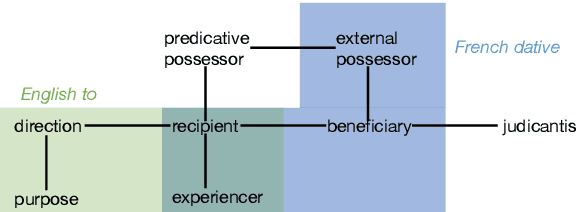


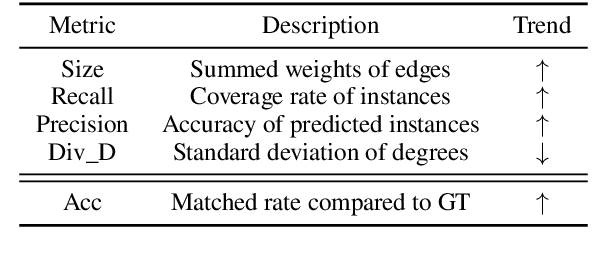
Abstract:Semantic map models (SMMs) construct a network-like conceptual space from cross-linguistic instances or forms, based on the connectivity hypothesis. This approach has been widely used to represent similarity and entailment relationships in cross-linguistic concept comparisons. However, most SMMs are manually built by human experts using bottom-up procedures, which are often labor-intensive and time-consuming. In this paper, we propose a novel graph-based algorithm that automatically generates conceptual spaces and SMMs in a top-down manner. The algorithm begins by creating a dense graph, which is subsequently pruned into maximum spanning trees, selected according to metrics we propose. These evaluation metrics include both intrinsic and extrinsic measures, considering factors such as network structure and the trade-off between precision and coverage. A case study on cross-linguistic supplementary adverbs demonstrates the effectiveness and efficiency of our model compared to human annotations and other automated methods. The tool is available at \url{https://github.com/RyanLiut/SemanticMapModel}.
CoMeDi Shared Task: Models as Annotators in Lexical Semantics Disagreements
Nov 19, 2024



Abstract:We present the results of our system for the CoMeDi Shared Task, which predicts majority votes (Subtask 1) and annotator disagreements (Subtask 2). Our approach combines model ensemble strategies with MLP-based and threshold-based methods trained on pretrained language models. Treating individual models as virtual annotators, we simulate the annotation process by designing aggregation measures that incorporate continuous similarity scores and discrete classification labels to capture both majority and disagreement. Additionally, we employ anisotropy removal techniques to enhance performance. Experimental results demonstrate the effectiveness of our methods, particularly for Subtask 2. Notably, we find that continuous similarity scores, even within the same model, align better with human disagreement patterns compared to aggregated discrete labels.
Evaluating Moral Beliefs across LLMs through a Pluralistic Framework
Nov 06, 2024Abstract:Proper moral beliefs are fundamental for language models, yet assessing these beliefs poses a significant challenge. This study introduces a novel three-module framework to evaluate the moral beliefs of four prominent large language models. Initially, we constructed a dataset containing 472 moral choice scenarios in Chinese, derived from moral words. The decision-making process of the models in these scenarios reveals their moral principle preferences. By ranking these moral choices, we discern the varying moral beliefs held by different language models. Additionally, through moral debates, we investigate the firmness of these models to their moral choices. Our findings indicate that English language models, namely ChatGPT and Gemini, closely mirror moral decisions of the sample of Chinese university students, demonstrating strong adherence to their choices and a preference for individualistic moral beliefs. In contrast, Chinese models such as Ernie and ChatGLM lean towards collectivist moral beliefs, exhibiting ambiguity in their moral choices and debates. This study also uncovers gender bias embedded within the moral beliefs of all examined language models. Our methodology offers an innovative means to assess moral beliefs in both artificial and human intelligence, facilitating a comparison of moral values across different cultures.
Eliminating the Language Bias for Visual Question Answering with fine-grained Causal Intervention
Oct 14, 2024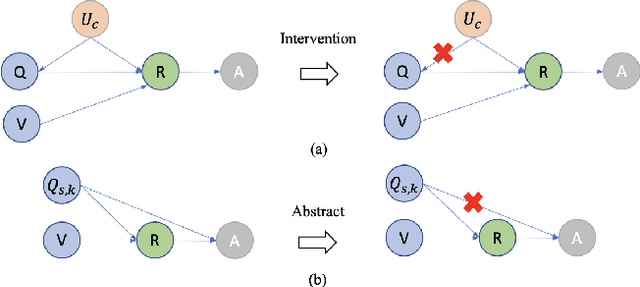
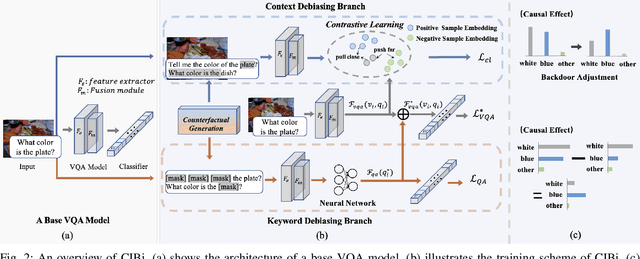
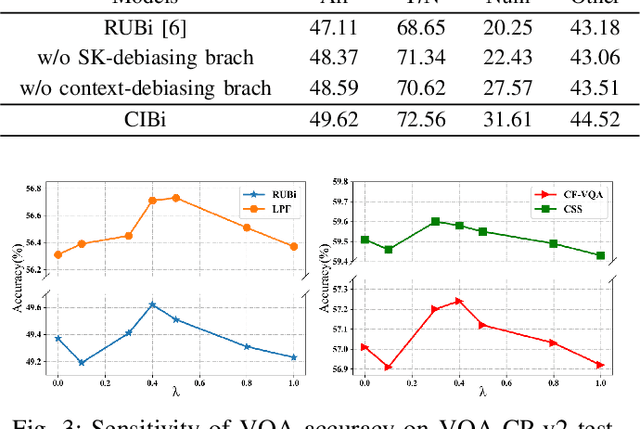

Abstract:Despite the remarkable advancements in Visual Question Answering (VQA), the challenge of mitigating the language bias introduced by textual information remains unresolved. Previous approaches capture language bias from a coarse-grained perspective. However, the finer-grained information within a sentence, such as context and keywords, can result in different biases. Due to the ignorance of fine-grained information, most existing methods fail to sufficiently capture language bias. In this paper, we propose a novel causal intervention training scheme named CIBi to eliminate language bias from a finer-grained perspective. Specifically, we divide the language bias into context bias and keyword bias. We employ causal intervention and contrastive learning to eliminate context bias and improve the multi-modal representation. Additionally, we design a new question-only branch based on counterfactual generation to distill and eliminate keyword bias. Experimental results illustrate that CIBi is applicable to various VQA models, yielding competitive performance.
Multi-Round Region-Based Optimization for Scene Sketching
Oct 05, 2024Abstract:Scene sketching is to convert a scene into a simplified, abstract representation that captures the essential elements and composition of the original scene. It requires semantic understanding of the scene and consideration of different regions within the scene. Since scenes often contain diverse visual information across various regions, such as foreground objects, background elements, and spatial divisions, dealing with these different regions poses unique difficulties. In this paper, we define a sketch as some sets of Bezier curves. We optimize the different regions of input scene in multiple rounds. In each round of optimization, strokes sampled from the next region can seamlessly be integrated into the sketch generated in the previous round of optimization. We propose additional stroke initialization method to ensure the integrity of the scene and the convergence of optimization. A novel CLIP-Based Semantic loss and a VGG-Based Feature loss are utilized to guide our multi-round optimization. Extensive experimental results on the quality and quantity of the generated sketches confirm the effectiveness of our method.
Artistic Portrait Drawing with Vector Strokes
Oct 05, 2024



Abstract:In this paper, we present a method, VectorPD, for converting a given human face image into a vector portrait sketch. VectorPD supports different levels of abstraction by simply controlling the number of strokes. Since vector graphics are composed of different shape primitives, it is challenging for rendering complex faces to accurately express facial details and structure. To address this, VectorPD employs a novel two-round optimization mechanism. We first initialize the strokes with facial keypoints, and generate a basic portrait sketch by a CLIP-based Semantic Loss. Then we complete the face structure through VGG-based Structure Loss, and propose a novel Crop-based Shadow Loss to enrich the shadow details of the sketch, achieving a visually pleasing portrait sketch. Quantitative and qualitative evaluations both demonstrate that the portrait sketches generated by VectorPD can produce better visual effects than existing state-of-the-art methods, maintaining as much fidelity as possible at different levels of abstraction.
Dynamic Evidence Decoupling for Trusted Multi-view Learning
Oct 04, 2024



Abstract:Multi-view learning methods often focus on improving decision accuracy, while neglecting the decision uncertainty, limiting their suitability for safety-critical applications. To mitigate this, researchers propose trusted multi-view learning methods that estimate classification probabilities and uncertainty by learning the class distributions for each instance. However, these methods assume that the data from each view can effectively differentiate all categories, ignoring the semantic vagueness phenomenon in real-world multi-view data. Our findings demonstrate that this phenomenon significantly suppresses the learning of view-specific evidence in existing methods. We propose a Consistent and Complementary-aware trusted Multi-view Learning (CCML) method to solve this problem. We first construct view opinions using evidential deep neural networks, which consist of belief mass vectors and uncertainty estimates. Next, we dynamically decouple the consistent and complementary evidence. The consistent evidence is derived from the shared portions across all views, while the complementary evidence is obtained by averaging the differing portions across all views. We ensure that the opinion constructed from the consistent evidence strictly aligns with the ground-truth category. For the opinion constructed from the complementary evidence, we allow it for potential vagueness in the evidence. We compare CCML with state-of-the-art baselines on one synthetic and six real-world datasets. The results validate the effectiveness of the dynamic evidence decoupling strategy and show that CCML significantly outperforms baselines on accuracy and reliability. The code is released at https://github.com/Lihong-Liu/CCML.
 Add to Chrome
Add to Chrome Add to Firefox
Add to Firefox Add to Edge
Add to Edge